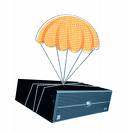
Western Digital Backup Plan
![]() Computers can and do fail and you usually get no warning before it’s too late. Backing up your data is no longer the chore that it once was. Here are some tips from Western Digital to help make it easier.
Computers can and do fail and you usually get no warning before it’s too late. Backing up your data is no longer the chore that it once was. Here are some tips from Western Digital to help make it easier.
Get organized
Put all the documents you create, the pictures you take, and the music you buy in a single master folder. Divide that master folder into sub folders to keep your files organized. Backing up your data becomes much easier if you only have one folder to back up. When all your personal files are in one place, you are less likely to forget a file when you back up. Organization is the secret.
Back up regularly
Get in the habit of backing up your files regularly. If you work on your computer daily, you should back up important files daily. Then, back up everything at least once a week. Better still, look for backup software that backs up your data automatically and instantly without manual or scheduled backups.
Be selective
You don’t have to back up your entire system. That’s a time consuming task that only duplicates all the issues you’ve built up over time on your hard drive. Save original copies of your software programs and reinstall your operating system and a clean copy of your software if your system crashes.
Back up what’s important to you
The most important things to protect are files you create yourself. Whether they are text documents, e-mail messages, pictures, music, videos, or game saves, if you made them, you want to save them and keep them nearby. It’s also helpful to back up the configuration settings for any programs you use, along with critical Windows data such as the registry. And don’t forget to make a duplicate copy of anything you have stored on external storage device.
Use backup software
Use backup software to automate your backup. You can make mistakes or omit something important if you back up manually. An easy-to-use backup program creates a backup of your data reliably and automatically, keeps logs, and notifies you in case of any problem. Most WD external hard drives come with backup software.
WD’s extensive line of external drives that include automatic backup software:
- My Book Home Edition
Preserve your precious memories with this ideal combination of elegant, reliable storage and automatic backup features. - My Book Office Edition
Protect your business assets and access them remotely with this easy-to-use combination of reliable storage and automatic backup features. Windows operating system required for remote access. - My Book Mirror Edition
Secure your vital data with WD’s My Book Mirror Edition dual-drive storage system with RAID Mirroring. With RAID-based continuous data protection, automatic data backup software, and user-serviceability, this is the perfect backup system for your irreplaceable data. - My Book Studio Edition
High-speed interfaces make this an ideal solution for creative professionals and video editors. - My Book Studio Edition II
Quad interface, RAID-enabled, about 30% less power consumption, formatted for Mac. The My Book Studio Edition II treads lightly on the earth and carries big performance for creative professionals. - My Book World Edition
Simplified set up and best-in-class performance make the My Book World Edition network drive the perfect choice for centralizing and backing up data on all the computers in your home. - WD ShareSpace
Plug this high-speed Gigabit Ethernet storage system into your small office or home network for centralized storage with plenty of capacity to go around. - My Passport Elite
These sleek little drives combine a luxurious, soft-touch finish with a clever capacity gauge, and backup, sync and encryption, and remote access software.
Where to backup
You can back up to CDs or DVDs, but this is a slow, manual process. And contrary to popular belief, most CDs and DVDs are not permanent. Low-priced CDRs may not be readable at all in as little as two years.
The best backup medium is an external hard drive. High capacity external drives are very fast and allow you to keep all your backed up data in one place. For extra safety, get a two-drive external storage system and dedicate half the capacity for mirroring to automatically and instantaneously back up your backup every time.


 1. Shareware: PC BackUp
1. Shareware: PC BackUp